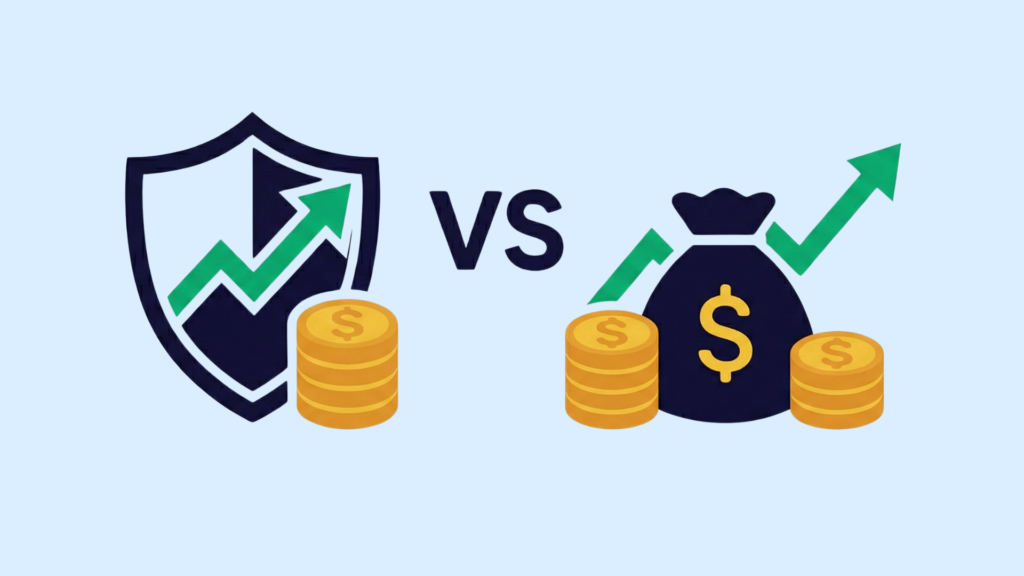Investing is one of the best ways to maximise funds and develop a passive income. However, investments are not just about gains; they also come with their fair share of losses. Thus, you must choose an ideal investment avenue that fits your risk appetite.
Mutual funds are one of the most favoured investment avenues. They are known for their reliability and considerable returns, and they are handled by experienced financial experts. However, there are three types of mutual funds: open-ended, closed-ended, and interval mutual funds.
Open-ended mutual funds are the most suitable option because of their unique features. If you do not know much about them, read this article until the end.
What are open-ended mutual funds?
Open-ended mutual funds are investment funds. Based on the Net Asset Value (NAV), it allows you to buy or sell share units from the fund at any time. The NAV is calculated at the end of each trading day by deducting the fund’s liabilities from the total value divided by the number of shares outstanding. There is no limit to shares in NAV; new shares can be issued when you buy and redeemed when you sell. This setup allows the participation in diverse assets accessible with a modest sum of money.
Key Features of Open-ended Mutual Funds
Here are a few key aspects that are crucial to understand open-ended mutual funds:
Liquidity
Liquidity is the ease of converting assets into cash without affecting the price. This makes open-end mutual funds a convenient option for accessing your funds without any hassle.
Unlimited Units
The use of funds to buy shares has no limited value. If you purchase more shares, additional units will be accommodated, catering to the demands. As the funds are accessible to new investors as well, it is open to growth.
No maturity date
Fixed-income instruments, like bonds, have an expiration date to redeem the shares. Open-ended mutual funds are more flexible as they have no maturity date. This allows you to make decisions for your shares based on market conditions.
Types of Open-ended Mutual Funds
There are various types of open-ended mutual funds based on the investment type:
Equity Open-Ended Funds
It offers stock investments with high returns and liquidity. Although it involves risk concerns, a strategic plan makes this diversified fund option the right choice for you.
Debt Open-Ended Funds
As the name suggests, open-ended funds generate profit by offering your investment as debt to companies or the government. It provides liquidity and diversification with low risk.
Hybrid Open-Ended Funds
Hybrid open-ended funds are a combination of equity and debt-type funds. It offers regular income and potential for growth and ensures security.
Sectoral or Thematic Open Ended Funds
It focuses on investing in a particular sector or theme, such as technology, sustainability, or healthcare. This diversified choice of funds ensures a high return.
Advantages of Open-ended Mutual Funds
High Liquidity
One key reason open-ended mutual funds are a good choice is the high level of liquidity they offer. This allows you to quickly and smoothly obtain your funds without penalties.
Diversification
It is a technique to dilute the distribution of money across various shares. It reduces the risk of poor performance affecting the investment and provides an opportunity to explore different markets, maximising the chance of profit.
Professional Management
The investments are managed by experts who understand different markets and have experience managing investments. This increases the chance of good decisions followed by returns.
Flexibility in investment options
It empowers you to choose from the diverse options that align with your financial plan. You can alter your portfolio to avoid risks based on the fluctuating market conditions.
SIP Availability
Systematic Investment Plans, or SIPs, are one of the most popular options for investing in open-ended mutual funds. They allow you to proceed in a structured manner through a monthly or quarterly contribution. They are a good approach to reaching a long-term goal that eases the management of funds.
Also Read: Equity Mutual Funds | Best trading App | Closed Ended Mutual Funds
Disadvantages of Open-ended Mutual Funds
Every investment comes with some chance of risk, but strong strategic planning is all it takes to tackle the cons. Here are a few disadvantages of open-ended funds:
Market Volatility
The market is ever-changing; it has upturns and downturns due to several aspects every now and then. Major market falls can lead to severe volatility in the fund value, which may reflect in your investment.
Impact of Large Redemptions
The net asset value (NAV) can decline in the case of higher units of redemption when several investors. This can disrupt the investment strategy and affect the remaining investors in the funds in case of frequent large redemptions.
High Cash Reserves
Open-ended mutual funds maintain higher cash reserves in order to maintain liquidity. When you demand high redemptions, fund assets may not generate growth effectively.
How Open-ended Mutual Funds Work
Asset Management Companies (AMC) create open-ended mutual funds. They pool money from various investors; each fund has a defined objective. You can buy any number of shares based on the net asset value (NAV), which is calculated daily. Fund managers manage the portfolio according to market conditions to meet structured strategies.
Moreover, you are free to redeem your shares at any time based on NAV, which offers flexibility and liquidity. To ensure transparency, you are provided with regular fund reports.
Differences Between Open-ended and Closed-ended Mutual Funds
Here is a comparative study of both types of mutual funds:
|
Aspects |
Open-ended Mutual Funds |
Closed-ended mutual funds |
|
Liquidity |
It offers high liquidity that allows you to buy and sell shares in a flexible manner. |
It offers limited liquidity that makes buying and selling shares complicated. |
|
Unit Pricing |
The unit pricing is based on NAV. It is calculated daily at the end of the day; you can buy or sell shares based on that price. |
The unit pricing differs from NAV. In this case, it is determined by the change in the stock exchange’s market dynamics. |
|
Investment Flexibility |
It has SIPs, high liquidity, and no trading restrictions. Additionally, the option to reinvest distributions makes it a flexible choice. |
It has fixed shares, and trading takes place in a secondary market. It also involves risks and restricted redemption, which makes it a less flexible option. |
Taxation of Open-ended Mutual Funds
Depending on the asset allocation of funds, here is a quick comparative study on the basis of long-term and short-term gains:
|
Basis |
Long-Term Capital Gains (LTCG) |
Short-Term Capital Gains (STCG) |
|
Equity-Oriented Open Ended Funds |
The profit earned from the sales held for over a year is known as LTCG. |
The profit earned from the sales that have been held for less than a year is known as STCG. |
|
If LTCG exceeds more than 1 lakh in a financial year, a 10% rate is taxed on it. |
STCG is taxed 15% of the entire amount on STCG. | |
|
Debt-Oriented Open Ended Funds |
LTCG refers to the profits earned from the units held for more than three years. |
STCG refers to the profits earned from the units held for less than three years. |
|
Along with indexation benefits, which effectively reduce the taxes, 20% is taxed on the profit. |
The profit is added to the investor’s income and taxed as per the applicable tax slab. |
How to Invest in Open-ended Mutual Funds?
Investing in mutual funds needs an appropriate approach. Here’s a step-by-step guide on how to invest in open-ended mutual funds:
- Research: The first step is to do thorough research and understand the market. This includes reading about past performances and investment objectives.
- Planning: After thorough research, it is important to determine the goals that you want to attain through investing and how much risk you can absorb against the investment amount.
- Create an Account: Complete your application and formalities by providing the required personal information to create an account. Once your account is set up, you will receive a confirmation.
- Start investing: You can start investing as soon as your account is created. Choose the mutual fund that aligns with your goals and objectives. It is essential to decide the method you want to invest in—lump sum, SIP, Direct, etc. Here is a critical analysis of some of the popular investment plans.
Direct vs. Regular Plans
|
Basis |
Direct Plan |
Regular Plan |
|
Managing your plans directly does not charge commissions from advisors, which leads to a lower expense ratio and higher return. |
Managing the funds by a broker or advisor has a higher expense ratio. The services they provide demand commission, which lowers the return. | |
|
Planning |
It allows you to understand the complexities of the market in order to reach your goal. This requires you to have a good understanding of the market. |
It allows you to prepare a strategic plan from experts to reach your goals. They understand market fluctuations and risk appetites through their experience, which leads to efficient decisions. |
Lump Sum vs. SIP
|
Basis |
SIP | |
|
Investment Approach |
A large amount has to be paid at once for investment. |
It allows you to pay a fixed amount at regular intervals, maintaining a disciplined approach. |
|
Flexibility |
It offers comparatively low returns in a shorter period of time. |
It helps you gain returns after a longer period, but the amount is comparatively higher. |
Who Should Invest in Open-Ended Mutual Funds?
You should invest in open-ended mutual funds if you have investment goals seeking flexible options that offer liquidity. Here is a brief idea for whom this open-ended mutual fund is suitable:
Risk-Averse Investors
You should invest if you are approaching high returns with minimum risks while prioritising the safety of your capital. Moreover, it is crucial for you to understand the risk tolerance you can take.
Growth-Oriented Investors
A growth-oriented investor has capital appreciation over income and often has a diversified portfolio. In order to be a growth-oriented investor, you must have a higher risk tolerance.
Investors Looking for Flexibility
Having an adaptable mindset while investing makes you an investor looking for flexibility. This includes expecting high liquidity and investments that can adjust to market fluctuations. You must maintain a proactive approach to understanding the market to achieve your goals.
The Bottom Line
Open-ended mutual funds offer a professionally managed investment opportunity with high liquidity. However, to make profitable investments, it is important to formulate a goal and understand your risk tolerance.
If you plan to invest in open-ended mutual funds, sign up with Appreciate Wealth. It is a safe and intuitive trading platform that allows you to invest in a variety of avenues, including mutual funds, fractions, etc. So, register your account and start investing today!
FAQs
Q1. What are open-ended mutual funds?
Open-ended mutual funds are investment funds that allow you to buy or sell units based on the net asset value (NAV).
Q2. How do open-ended mutual funds work?
Open-ended mutual funds allow you to buy or sell shares anytime, making the process straightforward with high liquidity.
Q3. What are the advantages of open-ended mutual funds?
Open-ended mutual funds offer high liquidity, diversification, professional management, flexibility, and SIP, making it the ideal choice for you.
Q4. How do open-ended funds differ from closed-ended funds?
The basic difference between the two is that closed-ended funds offer limited shares. On the other hand, open-ended funds issue shares as per your demand.
Q5. What is the tax treatment for open-ended mutual funds?
Profits in open-ended mutual funds are subject to taxes. Different rates and regulations are enforced based on fund type—debt and equity.
Q6. Can I invest in open-ended mutual funds through SIP?
Yes, you can invest in open-ended mutual funds through an SIP. This allows you to pursue long-term investment goals in a disciplined and structured manner.
Q7. Are open-ended mutual funds suitable for long-term investing?
Yes, as there are no restrictions on buying or selling shares, you can strategise a plan with long-term investment goals.
Q8. What are the risks associated with open-ended mutual funds?
Market volatility and high rates of redemption can be aspects of concern that might be reflected in your funds.
Q9. How is the NAV of an open-ended fund calculated?
It is calculated by deducting the fund’s liabilities from the total value divided by the number of shares outstanding at the end of each trading day.
Q10. Can I withdraw my money from an open-ended mutual fund at the time?
Yes, open-ended mutual funds have no maturity date; you are free to withdraw money anytime.
Q11. How do I choose the best open-ended mutual fund?
To invest in open-ended mutual funds, you must understand your risk tolerance, financial goals, and investment mode—lump sum or SIP.
Q12. How much money is required to start investing in open-ended mutual funds?
Open-ended mutual funds offer unlimited shares with no maturity date, which allows you to invest any amount at your convenience.
Disclaimer: Investments in securities markets are subject to market risks. Read all the related documents carefully before investing. The securities quoted are exemplary and are not recommendatory.























